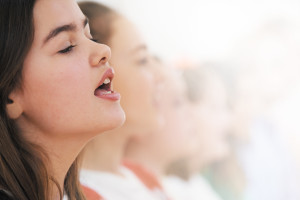Have you ever found yourself singing in the shower, especially when you think no one is listening? Whether you can carry a tune or not, you’ve probably done it.
 Sometimes there is a nice echo or reverberation, depending on how your bathroom is constructed. You don’t necessarily have to be musical to express your feelings through song; singing can be one of the most intimate and personal satisfactions in life.
Sometimes there is a nice echo or reverberation, depending on how your bathroom is constructed. You don’t necessarily have to be musical to express your feelings through song; singing can be one of the most intimate and personal satisfactions in life.
“Singing, a great and most cherished gift and privilege, has magical qualities that transcend all words, lifts the spirit and the soul and frees the singer to hope and dream in ways the human spirit longs for,” said the Founding Director of the Blackhawk Chorus, Diane Gilfether.
It is, no doubt, the most wide-spread kind of music making—being the only one, besides whistling, that does not depend on another instrument, according to the Harvard Dictionary of Music.
Indeed, the voice, as manifested in singing, is truly the first instrument.
The human voice sets us apart from all other creatures on earth. It is certainly one of the defining aspects of being human. The voice’s ability to sing and change pitch, makes it the most highly developed and sophisticated of all musical instruments.
“Being part of something bigger than yourself is not only enjoyable but beautiful and emotionally stirring,” according to William Hartshorn in his article, “The Role of Listening.” In Basic Concepts in Music Education he wrote, “It’s important for a child to listen to his own singing as well as that of others. By listening to themselves they may also find a basis for improving the quality and blend of their own voice.”
Vocal music reached its zenith in terms of development and perfection long before instrumental music. Development of instruments started out very crudely; all hand-made without modern acoustical equipment.
The early Colonists brought to America what they knew and were accustomed to in Europe, and particularly in England.
Singing schools emerged in the early 18th Century to teach and enhance singing, primarily for religious services in the Puritan churches. These schools were well established. They were taught by itinerant singing masters and were paid for by the people attending the schools.
Their purpose was to develop the ability to read music and interpret a wide variety of choral works. The rudiments of music and sight-singing were the basic core subjects. For better than a century, the singing schools were the primary institutions for musical training. They were an integral and omnipresent feature of American life and customs. The schools were in essence the forebears of contemporary public school music. By the close of the 18th Century, singing schools had become widespread. These schools lasted about 150 years.
An interesting sidelight of singing is found in an article in “Making Music,” Singing Helps Parkinson’s Patients to Communicate Better. Professional singer, Linda Ronstadt, stated that because she has Parkinson’s disease she can no longer sing.
This was disputed by Melinda Kurowski, a board certified music therapist. She works with Parkinson patients and says “Yes! They can sing.” It takes more effort to sing than it does to speak. The patients take part in exercises that teaches them what is involved in breath support. This makes the process of singing much more enjoyable even though the effort to sing requires more energy and diligence for them.
Through singing exercises they learn how to project their voices and have better articulation. Kurowski said that she can help over 90 percent of Parkinson’s patients.
Nick Stewart and two students from Oxford Brooks University in the United Kingdom, conducted a study with over 375 people who either sang in choirs, sang alone or were members of a sports team.
Stewart asked them about their experiences in their activities and they said their activities seemed to enhance their sense of well-being. Those who were singers saw their choirs as more “meaningful” than those that did not sing and those involved in team sports.
“Whether a professional or an amateur, a soloist or a chorister, a beginner or a seasoned veteran, the outpouring of emotion from the dedicated singer reaches to the heart of the listener,” said Gilfether. “It creates a communication of boundless pleasure and spirituality in a most unique way.”
Today singing is heard everywhere you go; from the nursery through elementary, high school and college, community groups and at local and national events. The music industry has ballooned exponentially in the past years with technological innovations bringing music and singing to the forefront of daily life.
There are all kinds of singers, from the lowest bass to the highest soprano; from the wildest rocker to the accomplished opera diva. The wonderful human voice is a marvelous machine of tones, melodies, inflections and sounds that no other instrument can duplicate.
So use your voice for your own enjoyment or for others to hear, and gain the satisfaction and fun it gives you—whether you can carry a turn or not. It’s an instrument you’ll always have with you and one you can cherish for a lifetime.
The Danville Community Band presents “Museums Around the World,” its annual concert at the Blackhawk Museum, 3700 Blackhawk Plaza Circle, Danville, CA. Sunday, April 10. 2016 at 2:00 p.m. Concert included with museum entrance fee. (Free to museum members). Please submit your questions and comments to banddirector01@comcast.net. Visit our website at www.danvilleband.org for up-to-date information about the Danville Community Band.
Leave a Reply